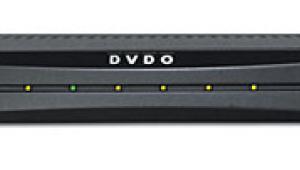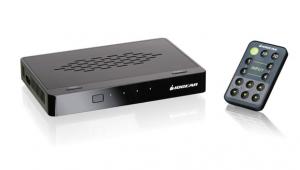DVDO iScan Ultra, DreamVision Optimizer, & Focus Enhancements CenterStage CS-1 Three Video Processors Page 2
The Optimizer delivered far better performance at the Quad setting than at 480p. Motion artifacts were not reduced, but noise and grain were less evident and the overall picture took on a creamier, more cinematic texture. Quad produced a slightly sharper picture than 480p. Overall, the Quad picture was somewhat better than what you can get from a good progressive scan DVD player connected directly to a projector, but the difference wasn't earthshaking. The Quad output from the Optimizer was nowhere near as sharp as the Faroudja Native Rate's 720p output, but that was not surprising considering the difference in price.
Focus Enhancements Centerstage CS-1
Focus Enhancements is better known for their image-processing products for the computer market than for their home-theater video processors, but they've been making HT products for several years now. I've used several of their earlier processors, and I've been impressed by those models' many features and extraordinary flexibility. The CenterStage CS-1 represents Focus Enhancements' latest thinking on what it takes to make a state-of-the-art video processor. At $1995, it makes a lot of promises, and delivers on most of them.

Focus Enhancements betrays their computer-geek origins on a full-featured website where you can get not only copies of user manuals, but the latest versions of their CenterStage Remote operating software with additional scan rates, FAQs, and even a list of optimal combinations of projector and output scan rate. FE's online support delivers more value than all but a few home-theater product manufacturers' websites.
Like other video processors, the CenterStage CS-1 performs both video switching and upscaling functions, but unlike other processors in its price range, it has greater flexibility and more setup options. In addition to pairs of composite, S-video, and interlaced component inputs, and one progressive component input, the CenterStage has DVI and VGA inputs, for a total of nine input options. Outputs include analog HD-15 and DVI.
A complete list of scan rates could fill a long paragraph, so check the list in "Specifications." In addition to the supplied resolutions, a large number of additional resolutions are available to download from the company's website. Most resolutions are available in RGB or Y-Pb-Pr component varieties, and many can be output at refresh rates of 60, 72, or 75Hz. You can even create your own resolution, according to specs from your display manufacturer. If the CS-1 doesn't handle a particular rate, it probably doesn't exist.
Inside its chassis, the CenterStage CS-1 has an advanced comb filter, auto-adaptive deinterlacing, a sophisticated scaler, 3:2 pulldown detection, and fully upgradeable software. If you need an SDI input, HDCP encryption support, and/or an additional hardware upgrade slot, the CenterStage CS-2 includes them for an additional $500. Focus Enhancements also makes the CenterStage CS-HD, which lacks user-definable output resolutions, DVI input, Flash-upgradeable firmware, and 11 of the CS-1's 27 scan rates. But it costs $1000 less.
 Despite all the output options available from the CS-1, there were some output selections that were not available in our review sample in component form (Y-Pr-Pb), without FE's PC-based control software, including the important HDTV variants of 1080i, 720p, and 1080p. To get these resolutions in RGB form (as most CRT projectors need) required downloading them from the FE website (PC-only). Fortunately my SIM2 SVD 800 Millennium CRT is an exception, with both RGB and component inputs, so I was able to use the CS-1's component output. According to Focus Enhancements, however, all models now ship with both RGB and Y-Pr-Pb HDTV resolutions. Other scan rates I tried included 1365x768, 1280x1024 (SXGA), 1280x768 (WXGA), 1024x768 (XGA), 852x480, and 800x600 (SVGA).
Despite all the output options available from the CS-1, there were some output selections that were not available in our review sample in component form (Y-Pr-Pb), without FE's PC-based control software, including the important HDTV variants of 1080i, 720p, and 1080p. To get these resolutions in RGB form (as most CRT projectors need) required downloading them from the FE website (PC-only). Fortunately my SIM2 SVD 800 Millennium CRT is an exception, with both RGB and component inputs, so I was able to use the CS-1's component output. According to Focus Enhancements, however, all models now ship with both RGB and Y-Pr-Pb HDTV resolutions. Other scan rates I tried included 1365x768, 1280x1024 (SXGA), 1280x768 (WXGA), 1024x768 (XGA), 852x480, and 800x600 (SVGA).
The buttons on the CS-1's remote perform all essential input and output switching functions, as well as menu navigation. Unfortunately, I managed to misplace the remote for most of the review period. (Those darn cats.) Fortunately, the front panel lets you operate the CS-1 without a remote, and if you choose an output setting that gives your monitor fits, you can still see what your selections are and adjust them accordingly on the unit's own display.
The CenterStage CS-1's main menu has four submenus. Picture Settings controls include Brightness, Contrast, Sharpness, Saturation, and Hue. Output Selections covers Resolution (scan rate), Output Aspect, Output Format (RGB or Y-Pb-Pr), Refresh Rate (60 or 72Hz), Sync on Green On/Off, Output Vertical and Horizontal Position, and Output Vertical and Horizontal Size. Input Selections include Input Aspect, Video Standard, and Input Vertical and Horizontal Position. Miscellaneous governs DSP mode, RS-232 baud rate, calibration, factory reset, and the software version information.
You might wonder why the CenterStage has position adjustments for input and output as well as size. With so many output scan rates that exhibit such a wide variety of geometries, you need to adjust each one to properly fit a CRT display. Even with an adjustment range of –50 to +50, I couldn't perfectly resize some scan rates, though most could be made to fit properly. Unfortunately, the CS-1 can't store position settings with each scan rate; if you need to change rates, you must readjust position for the new rate. This can take a while. But the CS-1 does store position adjustments on an input-by-input basis.
Enter, Stage Right
During the review period, the CenterStage CS-1 performed flawlessly. Other Focus Enhancement video processors I'd used occasionally exhibited quirky behavior, so it was reassuring to see that the CS-1 was operationally stable and ergonomically well-designed. It is definitely ready for prime time.
The CS-1 produced an image that rarely disappointed, but it didn't astound either. At 480p, its motion-detection circuitry did a somewhat better job than the Toshiba SD-9200 DVD player, and it equaled the EAD DVDMaster 8000 Pro and McIntosh MVP851 players. It was bettered by the iScan Ultra, which offered better motion control and, when adjusted carefully, slightly superior sharpness. In terms of video noise and color accuracy, the CS-1 performed on a par with anything I've seen short of the Faroudja Native Rate.
Reducing motion artifacts was not the CS-1's strong suit—it did an adequate job, but it couldn't match the less expensive iScan or the pricey Faroudja. At higher scan rates, the CS-1 delivered a slightly sharper picture, but its motion-detection abilities didn't change, regardless of the scan rate I chose. On the Video Essentials scene with the waving American flag, the CS-1 produced the same amount of motion artifacts at 480p and at 1364x768.
The CenterStage CS-1 had certain performance limits. It was no shock to find that in my system it never equaled the pricier Faroudja Native Rate's performance with respect to sharpness, noise, grain, or motion artifacts. But it does offer a remarkable amount of flexibility and establishes itself as preeminent in sheer numbers of scan rates. Once the processor was properly set up with the best output for my projector, however, much of this adaptability became moot. I suspect that a certain amount of the cost of the CS-1 stems from its many features and options, most of which you won't use once it's set up. Unless you desperately need an esoteric scan rate, DVI, and upgradeable firmware, the $1000-less-expensive CenterStage CS-HD would be far more cost-effective. With the same basic internal circuitry, it should deliver similar performance at a very attractive price
Three For the Road
Those who know me well usually describe my spending habits as "thrifty bordering on cheap." I buy used cars with low mileage rather than new ones, and I rarely purchase a more expensive home-theater component when a cheaper unit offers the same level of performance. For an extra, say, $1000, I expect more than "slightly better."
Given these proclivities, it should come as no surprise that my favorite of the three video processors reviewed here is the DVDO iScan Ultra. Although it's the least expensive, the iScan produces the best picture at 480p. The other processors offer higher scan rates, but their pictures were not sufficiently better in my system, even at those higher rates, to justify the higher costs. Perhaps a plasma or HD2-based DLP projector would make the higher scan rates available from the Dream-
Vision Optimizer and Focus Enhancements CenterStage CS-1 (or less expensive CS-HD) more of a buy, but with my 7-inch CRT projector those other scan rates just didn't produce an image markedly better than what you see with a top-flight DVD player.
While it might sound slightly wacky, I recommend that a potential buyer of a video processor spend $899 for a DVDO iScan Ultra or move up to the $3995 Faroudja Native Rate (the latter, in particular, if you're using a CRT projector with 8- or 9-inch tubes). Nothing else I've seen delivers enough of an improvement over the iScan to justify the added expense. Sometimes life is tough.
Getting in Deep with DVI
Steven Stone is unable to evaluate DVI connections in his system, but I was able to try the DVI output from the DVDO iScan Ultra with both a Sharp XV-Z10000 DLP projector and the Hitachi 51SWX 20B rear-projection CRT. With the Hitachi, I could get no image at all. With the Sharp, the DVI source locked the display into one of two aspect ratio modes, neither of which unsqueezed the image to fill the full width of my 16:9 screen. I tried both DVI setup options provided on the iScan and got the same results.
This isn't the first problem we've experienced with a DVI connection (we've had similar difficulties with the Bravo D-1 DVD player from V Inc.—report next month—and at least one home theater PC that we'll be reporting on later in the year). We're seeing a variety of problems with this interface in different combinations of source and display. Some combinations do work properly—for example, the V Inc. DVD player into the Fujitsu P50XHA10U plasma. So it's too early to state definitively just where the blame might lie when they don't. In the meantime, a word to the wary: If you have your heart set on a DVI link between your display and a video processor, HD tuner, or DVD player, make certain that the source will function properly with your specific video monitor or projector.—Thomas J. Norton
- Log in or register to post comments



























































